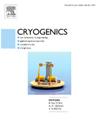Absorption of liquid nitrogen into porous materials used in the cryogenic cold chain
Abstract
A dry-shipper is a dewar used to transport frozen biomedical samples at cryogenic temperature. The inside of the dewar is lined with a porous material that absorbs and prevents the spillage of liquid nitrogen during transportation. In these porous materials vapor might be trapped during filling of the dry-shipper leading to a lower transport and storage time. The conditions under which the vapor is formed and the relationship with the porous material properties is not well understood. We studied the impact of the pore size distribution on the vapor retention in the porous materials by comparing liquid nitrogen absorption in aluminosilicate material with relatively large pores (1-100 μm) and calciumsilicate with small pores (∼0.45 μm). Both samples were immersed into saturated liquid nitrogen and a comparison of the absorbed liquid volume fraction with the porosity showed the calciumsilicate sample was completely filled with liquid, whereas the aluminosilicate contained a vapor fraction of about twenty percent. As a further investigation, we studied the absorption characteristics in subcooled liquid nitrogen. In this case, both materials absorbed liquid equivalent to their respective void fraction indicating no vapor pockets in the material. From these results, we propose a design property window for potential new porous materials for use in the dry-shippers.

 求助内容:
求助内容: 应助结果提醒方式:
应助结果提醒方式:


